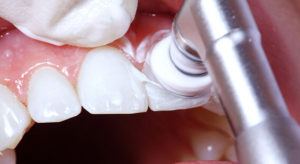
The procedure of ultrasonic cleaning of the teeth is done with the help of an ultrasound device. Manipulation is considered relatively painless and one hundred percent safe for the tooth enamel. It is recommended to start each treatment of the gums or teeth with ultrasound. After the procedure, a stronger connection of the filling with the tooth surface is possible. The principle of operation of the ultrasonic device is that the scaler acts on the hard tissues of the stone, destroying and peeling them off from the enamel. The amplitude and frequency of oscillations of the ultra sound (U-S) do not have any effect on the tooth enamel itself. Ultrasonic cleaning of teeth is carried out in several stages and lasts no more than one hour.
This cleaning gives a certain whitening effect.
Ultrasonic cleaning of teeth, depending on the individual recommendations of specialists, should be carried out every 6 or 12 months. After the ultrasound step, polishing of the teeth is performed, using brushes or rubber cups. Rotating, they smooth and even clean the surface of the tooth creating gloss on the tooth surface, which reduces the possibility of re-formation of plaque and hard dental deposits. Polishing is done by applying different dispersed pastes on the surface of the teeth.
After the procedure, tooth sensitivity sometimes increases temporarily. Since polishing is usually combined with the removal of plaque, it is not recommended to eat coloring products for a while, as well as to smoke. Usually the process is well tolerated by patients, without pain and discomfort. The enamel of the teeth is definately not damaged.
Indications for the procedure:
In addition to absolutely healthy people, professional teeth cleaning is also necessary when the following symptoms are detected:
- Yellowing of the teeth;
- Tartar;
- Bleeding or swelling of the gums;
- Unpleasant smell that cannot be removed even with rinsing;
- As a preliminary preparation before teeth whitening;
- Before starting treatment of teeth and gums;
- Regular, complex teeth cleaning is required for those who wear braces or have crowns;
Relative contraindications to the procedure?
Each medical procedure has its own subtleties, so before you begin removing tartar, make sure that you have no contraindications, such as:
- Super sensitive enamel;
- Exacerbated periodontitis;
- Use of pacemakers;
- Cardiac arrhythmia;
- Endocarditis;
- Acute respiratory infections;
- The presence of diseases (HIV, hepatitis, tuberculosis, asthma, chronic bronchitis, viral diseases – occurring in the acute form);
- Problems with the cardiovascular system;
- Insufficiency: hepatic, renal, pulmonary;
- Ultrasonic teeth cleaning is not carried out in the area where there are implants or orthopedic structures;
- Ultrasonic cleaning of teeth is not carried out for children who have deciduous teeth, recently erupted permanent teeth, as well as in the process of changing the bite;
The consequences of dental deposits are well known – gingivitis, stomatitis, caries, and periodontitis. Therefore, cleaning teeth from plaque and tartar, is an affordable and inexpensive method of preventing diseases in the oral cavity.


Leave a Reply